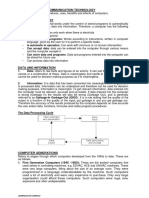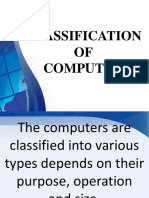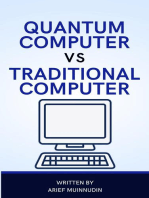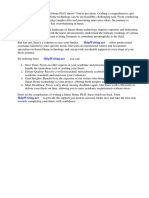Lecture 2 Notes Introduction To Computer
Uploaded by
ruothjoshua999Lecture 2 Notes Introduction To Computer
Uploaded by
ruothjoshua999lOMoARcPSD|49093645
Lecture 2 notes - INTRODUCTION TO COMPUTER
Information Communication technology (Kaimosi Friends University College)
Scan to open on Studocu
Studocu is not sponsored or endorsed by any college or university
Downloaded by Ruoth Joshua (ruothjoshua999@gmail.com)
lOMoARcPSD|49093645
KAIMOSI FRIENDS UNIVERSITY COLLEGE
(A CONSTITUENT COLLEGE OF MASINDE MULIRO UNIVERSITY OF SCIENCE AND TECHNOLOGY)
BIT 113: INFORMATION TECHNOLOGY FUNDAMENTALS
LESSON 2: CLASSIFICATION OF COMPUTERS
Classification of computers
Computers can be classified in terms of type, cost, size, capability and generations.
1.2.1. Classification in terms of type
• Digital computers:
– They use digital circuits and are designed to operate on two states, namely bits 0 and
1. They are analogous to states ON and OFF. Data on these computers is represented
by combinations of discrete pulses usually denoted by 0’s and 1’s. These computers
use the discrete numbering system in data processing. Digital computers are suitable
for complex computation and have higher processing speeds. They are
programmable. Digital computers are either general purpose computers or special
purpose ones. General purpose computers, as their name suggests, are designed for
specific types of data processing while general purpose computers are meant for
general use.
• Analog computers:
– These are almost extinct today. These are different from a digital computer because
an analog computer can perform several mathematical operations simultaneously. It
uses continuous variables for mathematical operations and utilizes mechanical or
electrical energy. These are the computers in which data is represented by a
Downloaded by Ruoth Joshua (ruothjoshua999@gmail.com)
lOMoARcPSD|49093645
continuously variable physical quantity such as voltage or angular position. They
include voltmeter, ammeter, speedometer, etc.
• Hybrid computers:
– These computers use both analog and digital techniques. In this type of computers,
the digital segments perform process control by conversion of analog signals to
digital ones. They are mostly used as Expert system that is found in scientific
Research & Engineering computers. They include weather forecasting computers,
Astronomical computers, the I.C.U in the hospitals.
• Embedded system computers:
– These are microprocessors that are attached to other electronic machines and are used
to control the actions of these machines but they are not accessed directly. They
include the petrol pump controller in electric fuel injection cars. They are also found
in the modern music machines, video decks and cameras, etc.
1.2.2. Classification in terms of cost, size and capacity
Super and maxi computers:
The highly calculation-intensive tasks can be effectively performed by means of supercomputers.
Quantum physics, mechanics, weather forecasting, molecular theory are best studied by means of
supercomputers. Their ability of parallel processing and their well-designed memory hierarchy
give the supercomputers, large transaction processing powers.
• These perform intensive work like weather forecasting.
• They have a high processing speed.
They have high energy requirements.
• They have very many processors and peripherals.
Mainframe computers:
Large organizations use mainframes for highly critical applications such as bulk data processing
and ERP. Most of the mainframe computers have capacities to host multiple operating systems
and operate as a number of virtual machines. They can substitute for several small servers.
• They are big in size.
Downloaded by Ruoth Joshua (ruothjoshua999@gmail.com)
lOMoARcPSD|49093645
• They have a large memory and backup storage.
• They have vast peripherals.
• They have a high processing speed.
Mini computers:
• They are smaller than the mainframe computers.
• They have low storage capacity as compared to the
• Mainframe computers.
• They are less powerful than the mainframe computers.
• They are used in stock control.
• They can have up to 8 terminals.
Micro computers:
A computer with a microprocessor and its central processing unit is known as a microcomputer.
They do not occupy space as much as mainframes or mini do. When supplemented with a
keyboard and a mouse, microcomputers can be called personal computers. A monitor, a keyboard
and other similar input-output devices, computer memory in the form of RAM and a power
supply unit come packaged in a microcomputer. These computers can fit on desks or tables and
prove to be the best choice for single-user tasks.
• They are smaller and cheaper in cost compared to mini computers.
• They are slow as compared to mini computers.
• They can allow graphical inputs.
• They are also known as Personal Computers (P.C.)
• They require one person to operate.
• These are popular in small business applications.
Downloaded by Ruoth Joshua (ruothjoshua999@gmail.com)
lOMoARcPSD|49093645
Note: In some cases there can be an overlap in terms of cost and performance of the above
classification i.e. there is a possibility of having a microcomputer that is far much costly and
better performance compared to a given minicomputer. Therefore the performance against cost
graph can be drawn as below. Other types of computers include: ˆ
• Desktops: A desktop is intended to be used on a single location. The spare parts of a
desktop computer are readily available at relatively lower costs. Power consumption is
not as critical as that in laptops. Desktops are widely popular for daily use in the
workplace and households. ˆ
• Laptops: Similar in operation to desktops, laptop computers are miniaturized and
optimized for mobile use. Laptops run on a single battery or an external adapter that
charges the computer batteries. They are enabled with an inbuilt keyboard, touch pad
acting as a mouse and a liquid crystal display. Their portability and capacity to operate
on battery power have proven to be of great help to mobile users. ˆ
• Netbooks: They fall in the category of laptops, but are inexpensive and relatively
smaller in size. They had a smaller feature set and lesser capacities in comparison to
regular laptops, at the time they came into the market. But with passing time, netbooks
too began featuring almost everything that notebooks had. By the end of 2008, netbooks
had begun to overtake notebooks in terms of market share and sales. ˆ
Personal Digital Assistants (PDAs): It is a handheld computer and popularly known as a
palmtop. It has a touch screen and a memory card for storage of data. PDAs can also be
used as portable audio players, web browsers and smartphones. Most of them can access
the Internet by means of Bluetooth or Wi-Fi communication. ˆ
• Servers: They are computers designed to provide services to client machines in a
computer network. They have larger storage capacities and powerful processors.
Running on them are programs that serve client requests and allocate resources like
memory and time to client machines. Usually they are very large in size, as they have
large processors and many hard drives. They are designed to be fail-safe and resistant to
crash. ˆ
• Wearable Computers: A record-setting step in the evolution of computers was the
creation of wearable computers. These computers can be worn on the body and are often
used in the study of behavior modeling and human health. Military and health
professionals have incorporated wearable computers into their daily routine, as a part of
such studies. When the users’ hands and sensory organs are engaged in other activities,
Downloaded by Ruoth Joshua (ruothjoshua999@gmail.com)
lOMoARcPSD|49093645
wearable computers are of great help in tracking human actions. Wearable computers do
not have to be turned on and off and remain in operation without user intervention.
• Tablet Computers: Tablets are mobile computers that are very handy to use. They use
the touch screen technology. Tablets come with an onscreen keyboard or use a stylus or
a digital pen. Apple’s iPad redefined the class of tablet computers. These were some of
the different types of computers used today. Looking at the rate of advancement in
technology, we can definitely look forward to many more in the near future.
1.2.3. Classification in terms of generations
The history of computer development is often referred to in reference to the different generations
of computing devices. Each generation of computer is characterized by a major technological
development that fundamentally changed the way computers operate, resulting in increasingly
smaller, cheaper, more powerful and more efficient and reliable devices.
First Generation - 1940-1956: Vacuum Tubes
The first computers used vacuum tubes for circuitry and magnetic drums for memory, and were
often enormous, taking up entire rooms. They were very expensive to operate and in addition to
using a great deal of electricity, generated a lot of heat, which was often the cause of
malfunctions. First generation computers relied on machine language to perform operations, and
they could only solve one problem at a time. Input was based on punched cards and paper tape,
and output was displayed on printouts. The UNIVAC and ENIAC computers are examples of
first-generation computing devices. The UNIVAC was the first commercial computer delivered
to a business client, the U.S. Census Bureau in 1951.
Second Generation - 1956-1963: Transistors
Transistors replaced vacuum tubes and ushered in the second generation of computers. The
transistor was invented in 1947 but did not see widespread use in computers until the late 50s.
The transistor was far superior to the vacuum tube, allowing computers to become smaller, faster,
cheaper, more energy-efficient and more reliable than their first-generation predecessors. Though
the transistor still generated a great deal of heat that subjected the computer to damage, it was a
vast improvement over the vacuum tube. Second-generation computers still relied on punched
cards for input and printouts for output. Second-generation computers moved from cryptic binary
machine language to symbolic, or assembly, languages, which allowed programmers to specify
instructions in words. High-level programming languages were also being developed at this time,
such as early versions of COBOL and FORTRAN. These were also the first computers that
Downloaded by Ruoth Joshua (ruothjoshua999@gmail.com)
lOMoARcPSD|49093645
stored their instructions in their memory, which moved from a magnetic drum to magnetic core
technology. The first computers of this generation were developed for the atomic energy industry.
Third Generation - 1964-1971: Integrated Circuits
The development of the integrated circuit was the hallmark of the third generation of
computers. Transistors were miniaturized and placed on silicon chips, called semi-conductors,
which drastically increased the speed and efficiency of computers. Instead of punched cards
and printouts, users interacted with third generation computers through keyboards and
monitors and interfaced with an operating system, which allowed the device to run many
different applications at one time with a central program that monitored the memory.
Computers for the first time became accessible to a mass audience because they were smaller
and cheaper than their predecessors.
Fourth Generation - 1971-Present: Microprocessors
The microprocessor brought the fourth generation of computers, as thousands of integrated
circuits were built onto a single silicon chip. What in the first generation filled an entire room
could now be put in the palm of the hand. The Intel 4004 chip, developed in 1971, located all
the components of the computer - from the central processing unit and memory to input/output
controls - on a single chip. In 1981 IBM introduced its first computer for the home user, and in
1984 Apple introduced the Macintosh. Microprocessors also moved out of the realm of
desktop computers and into many areas of life as more and more everyday products began to
use microprocessors. As these small computers became more powerful, they could be linked
together to form networks, which eventually led to the development of the Internet. Fourth
generation computers also saw the development of GUIs, the mouse and hand-held devices.
Fifth Generation - Present and Beyond: Artificial Intelligence
Fifth generation computing devices, based on artificial intelligence, are still in development,
though there are some applications, such as voice recognition, that are being used today. The
use of parallel processing and superconductors is helping to make artificial intelligence a
reality. Quantum computation and molecular and nanotechnology will radically change the
face of computers in years to come. The goal of fifth-generation computing is to develop
devices that respond to natural language input and are capable of learning and self-
organization.
Downloaded by Ruoth Joshua (ruothjoshua999@gmail.com)
lOMoARcPSD|49093645
Downloaded by Ruoth Joshua (ruothjoshua999@gmail.com)
You might also like
- Lenovo IdeaPad Z580 Quanta LZ3 - LZ3A SchematicNo ratings yetLenovo IdeaPad Z580 Quanta LZ3 - LZ3A Schematic44 pages
- DIFFERENT TYPES OF COMPUTERS AND CLASSIFICATION OF COMPUTERSNo ratings yetDIFFERENT TYPES OF COMPUTERS AND CLASSIFICATION OF COMPUTERS15 pages
- LESSON 11 - UNDERSTANDING COMPUTER types of computerNo ratings yetLESSON 11 - UNDERSTANDING COMPUTER types of computer21 pages
- Unit_II_Types of Computer_d55199a19e39b871054d7c2497501599No ratings yetUnit_II_Types of Computer_d55199a19e39b871054d7c24975015997 pages
- ClasClassification of Computers According To Size and Purposesification of Computers According To Size and PurposeNo ratings yetClasClassification of Computers According To Size and Purposesification of Computers According To Size and Purpose5 pages
- Different Types of Computers: Hom e Topi Cs Arti Cle SNo ratings yetDifferent Types of Computers: Hom e Topi Cs Arti Cle S4 pages
- TLE 10 - CSS (Week 1 Day 1) ASSEMBLE COMPUTER HARDWARENo ratings yetTLE 10 - CSS (Week 1 Day 1) ASSEMBLE COMPUTER HARDWARE35 pages
- Classification of Computers Based on Size and Capacity (1)No ratings yetClassification of Computers Based on Size and Capacity (1)13 pages
- Classification of Computers According To Technology and Size90% (20)Classification of Computers According To Technology and Size12 pages
- Lesson 5 Understanding Computer (Autosaved)No ratings yetLesson 5 Understanding Computer (Autosaved)27 pages
- O Level ZIMSEC - Computer Studies Notes - Inyathi HighNo ratings yetO Level ZIMSEC - Computer Studies Notes - Inyathi High86 pages
- Studio Type: Lampiran 3/schedule 3 Tiktok Shop Livestreaming Obs GuidelinesNo ratings yetStudio Type: Lampiran 3/schedule 3 Tiktok Shop Livestreaming Obs Guidelines8 pages
- Backdoor: Making Microphones Hear Inaudible Sounds: Nirupam Roy, Haitham Hassanieh, Romit Roy ChoudhuryNo ratings yetBackdoor: Making Microphones Hear Inaudible Sounds: Nirupam Roy, Haitham Hassanieh, Romit Roy Choudhury13 pages
- Soal Pas Semester Genap Kelas 10 Bahasa Inggris PDFNo ratings yetSoal Pas Semester Genap Kelas 10 Bahasa Inggris PDF7 pages
- Samsung Ue32es5500 Ue40es5500 Ue46es5500 Ue32eh5300 Ue40eh5300 Ue46eh5300 Ue26eh4500 Ue22es5400 TrainingNo ratings yetSamsung Ue32es5500 Ue40es5500 Ue46es5500 Ue32eh5300 Ue40eh5300 Ue46eh5300 Ue26eh4500 Ue22es5400 Training138 pages
- 23.8 Inch 2nd Gen I Series Panel PC Product Manual-I7No ratings yet23.8 Inch 2nd Gen I Series Panel PC Product Manual-I71 page
- Module 1 Introduction To Information and Communications Technology (ICT)No ratings yetModule 1 Introduction To Information and Communications Technology (ICT)15 pages
- These Adjectives Are Exceptions To The Rule. What Are Their Comparative and Superlative Forms?No ratings yetThese Adjectives Are Exceptions To The Rule. What Are Their Comparative and Superlative Forms?4 pages
- Xiaomi Redmi 9A Negro Xiaomi Redmi 9A Verde Xiaomi Redmi 9A AzulNo ratings yetXiaomi Redmi 9A Negro Xiaomi Redmi 9A Verde Xiaomi Redmi 9A Azul54 pages
- Case No.3 Questions 1. in Which Ways Do Smart Phones Help These Companies Be More Profitable? To What Extent100% (1)Case No.3 Questions 1. in Which Ways Do Smart Phones Help These Companies Be More Profitable? To What Extent2 pages
- Competitive Analysis: Direct Direct Direct IndirectNo ratings yetCompetitive Analysis: Direct Direct Direct Indirect2 pages
- Get Started With Easyconnect Ec220 Starter KitNo ratings yetGet Started With Easyconnect Ec220 Starter Kit12 pages
- DIFFERENT TYPES OF COMPUTERS AND CLASSIFICATION OF COMPUTERSDIFFERENT TYPES OF COMPUTERS AND CLASSIFICATION OF COMPUTERS
- LESSON 11 - UNDERSTANDING COMPUTER types of computerLESSON 11 - UNDERSTANDING COMPUTER types of computer
- Unit_II_Types of Computer_d55199a19e39b871054d7c2497501599Unit_II_Types of Computer_d55199a19e39b871054d7c2497501599
- ClasClassification of Computers According To Size and Purposesification of Computers According To Size and PurposeClasClassification of Computers According To Size and Purposesification of Computers According To Size and Purpose
- Different Types of Computers: Hom e Topi Cs Arti Cle SDifferent Types of Computers: Hom e Topi Cs Arti Cle S
- TLE 10 - CSS (Week 1 Day 1) ASSEMBLE COMPUTER HARDWARETLE 10 - CSS (Week 1 Day 1) ASSEMBLE COMPUTER HARDWARE
- Classification of Computers Based on Size and Capacity (1)Classification of Computers Based on Size and Capacity (1)
- Classification of Computers According To Technology and SizeClassification of Computers According To Technology and Size
- O Level ZIMSEC - Computer Studies Notes - Inyathi HighO Level ZIMSEC - Computer Studies Notes - Inyathi High
- Studio Type: Lampiran 3/schedule 3 Tiktok Shop Livestreaming Obs GuidelinesStudio Type: Lampiran 3/schedule 3 Tiktok Shop Livestreaming Obs Guidelines
- Backdoor: Making Microphones Hear Inaudible Sounds: Nirupam Roy, Haitham Hassanieh, Romit Roy ChoudhuryBackdoor: Making Microphones Hear Inaudible Sounds: Nirupam Roy, Haitham Hassanieh, Romit Roy Choudhury
- Soal Pas Semester Genap Kelas 10 Bahasa Inggris PDFSoal Pas Semester Genap Kelas 10 Bahasa Inggris PDF
- Samsung Ue32es5500 Ue40es5500 Ue46es5500 Ue32eh5300 Ue40eh5300 Ue46eh5300 Ue26eh4500 Ue22es5400 TrainingSamsung Ue32es5500 Ue40es5500 Ue46es5500 Ue32eh5300 Ue40eh5300 Ue46eh5300 Ue26eh4500 Ue22es5400 Training
- 23.8 Inch 2nd Gen I Series Panel PC Product Manual-I723.8 Inch 2nd Gen I Series Panel PC Product Manual-I7
- Module 1 Introduction To Information and Communications Technology (ICT)Module 1 Introduction To Information and Communications Technology (ICT)
- These Adjectives Are Exceptions To The Rule. What Are Their Comparative and Superlative Forms?These Adjectives Are Exceptions To The Rule. What Are Their Comparative and Superlative Forms?
- Xiaomi Redmi 9A Negro Xiaomi Redmi 9A Verde Xiaomi Redmi 9A AzulXiaomi Redmi 9A Negro Xiaomi Redmi 9A Verde Xiaomi Redmi 9A Azul
- Case No.3 Questions 1. in Which Ways Do Smart Phones Help These Companies Be More Profitable? To What ExtentCase No.3 Questions 1. in Which Ways Do Smart Phones Help These Companies Be More Profitable? To What Extent
- Competitive Analysis: Direct Direct Direct IndirectCompetitive Analysis: Direct Direct Direct Indirect

























































































